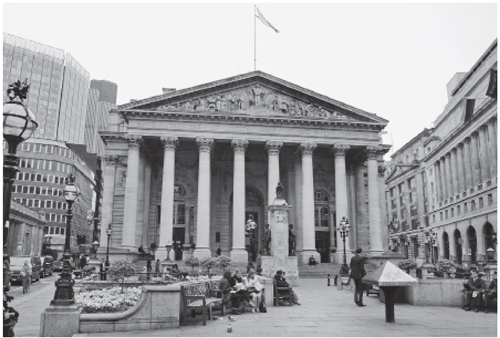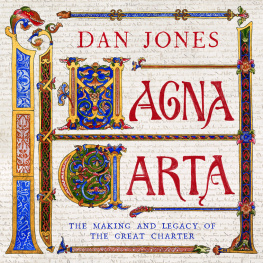
To Stan Revill
My history teacher long gone, but still living in this book.
CONTENTS

1. The Royal Exchange
2. Runnymede
3. The Fens
4. Clarendon Palace
5. Acre
6. Angoulme
7. Mirebeau-en-Poitou
8. Chateau Gaillard
9. The Marches
10. Laxton
11. Lincoln
12. Temple Ewell
13. Bouvines
14. The British Library
15. The Wash
16. Worcester Cathedral
17. The Internet
18. Palace of Westminster
19. Jamestown
20. Washington DC
A MAGNIFICENT MYTH
A cross the road from the Bank of England stands what looks like a vast temple with eight pairs of massive Corinthian columns along its front rising 90 feet into the air. You could imagine the entrance was built this high so that giants, or gods, could stride in without ducking. When TV economics correspondents want to go live in the City of London and tell us on the six oclock news about the latest GDP figures or the shrinking fiscal deficit, they ask their camera crews to set up so well see it in the background. The building exudes dignity and reliability. It says this is where weighty matters are decided. Its called the Royal Exchange. And it makes the nearby Bank of England in Threadneedle Street look by comparison like a warehouse with a church on top, or a Las Vegas shopping mall pretending to be Grecian.
But the Royal Exchange isnt a temple, not in the religious sense, though you could argue that what goes on inside is a cult. Theres a 10-foot-high statue of a crowned goddess at the top of its facade. She represents Commerce, and from the street we can see her right elbow leaning implausibly on the prow of a ship, while a beehive, positioned dangerously close to her left armpit, signifies how very busy her adherents are down below. Charles Dickens knew the Royal Exchange simply as The Change, and in A Christmas Carol , Scrooge sold debts here, and was taken by the Ghost of Christmas Yet To Come to see its merchants as they hurried up and down, and chinked the money in their pockets, and conversed in groups, and looked at their watches, and trifled thoughtfully with their great gold seals.
But the reason weve come to the Royal Exchange is neither to trade nor to admire the architecture. Were here to look at a painting commissioned by the Exchanges governors at the end of the nineteenth century to commemorate the freedom without which the goddess Commerce couldnt function. The picture shows the birth, in the year 1215 on the banks of the River Thames at Runnymede, of Magna Carta, also known as the Great Charter of Liberties, when King John was backed into a corner by the mightiest barons of England and forced to issue the document thats come to be regarded down the ages and over much of the planet ever since as the foundation of civil liberty and the rule of law.

At the top of the wide flight of steps leading to the Exchanges entrance, I pass between the towering columns, then through a pair of glass doors. It turns out that, if the Bank of England is a solid institution that looks like a shopping mall, the Royal Exchange only looks like a solid institution but is in fact a shopping mall. The interior of the building is formed as a single room, thats room in the sense that a cathedral nave is a room. It rises to a glass ceiling 80 feet above its marble floor. As shopping malls go, its the uppermost of the upmarket variety. All along its sides, extravagantly lit windows between stone archways show off the sort of necklaces and watches royalty might wear on gala night at the palace. There are only two or three of these sparkling items in each showcase, which tells you all you need to know about their price. Discreet illuminated signs announce that Bvlgari, Tiffany & Co., Agent Provocateur and Lulu Guinness feel at home here. The whole floor of this well-ordered Aladdins cave is filled with small round tables and ladderback chairs, most of them occupied by men and women in sharp dark suits, leaning forward, neglecting their lattes and croissants, and looking intently at each other or at their laptop screens. I feel like an alien in my jeans and dark green thorn-proof country-style jacket. But I pull out my camera, zoom it back to a wide angle and have just snapped the glittering scene when the viewfinder is blocked by a blurred face which is speaking.

The Royal Exchange, temple of commerce. Its governors commissioned Ernest Normands painting of the sealing of Magna Carta in the 1890s.
Sorry, sir, it says, photography is not allowed anywhere in the Royal Exchange. Its a man in dark grey trousers rising to a buttoned-up black overcoat. His tie is golden. He points at the camera, and, perhaps assuming Im a bumpkin, slow on the uptake, says, Its prohibited.
Whys that then? I ask.
Security, he replies, and Im expecting him to escort me from the premises. But you may walk around and look, he concedes, just in case I think Ive a right to order a cup of peppermint tea and sit down.
The Royal Exchange, as you might imagine, has been a target for jewel thieves. In one recent heist, two figures in motorcycle gear and armed with axes broke through the outer wrought iron gates on a Saturday night when the place was closed. They smashed display cabinets and snatched watches worth 300,000 (at a guess, thats about four watches). Their accomplices were waiting outside on motorbikes. They all sped off and lost their police pursuers. This particular mob were dubbed (as tabloid newspapers put it) the Fagins Kitchen gang, because the thieves, though not quite as young as Oliver Twist and the Artful Dodger, were teenagers.
I said the place is now an upmarket shopping mall, and so it is, but nevertheless it still serves its original purpose. The first Exchange on this site was opened by Queen Elizabeth I in 1570 as a meeting-place for merchants. That building burned down in the Great Fire of London in 1666, and its replacement too went up in flames in the early nineteenth century. The monumental structure were visiting today was inaugurated by Queen Victoria in 1845 for the convenience of merchants and bankers. The merchants and bankers are still here, though nowadays they insist on fresh ground coffee and waitress service for their client meetings, in a place where, when the deals done, they can blow their bonuses at Bvlgari or Tiffanys.
In some senses, Magna Carta itself, back in 1215, was a business deal. When hostilities had broken out between King John and the rebel barons earlier that year, the City of London already a thriving trade centre saw a commercial opportunity. The canny burghers of the city pitched their support behind the barons. It was a game-changer. It tipped the balance away from John, who now saw he had to reach an agreement with his opponents, if only to buy time. Charters granting certain concessions to towns were commonplace in the early thirteenth century. And in return for backing the rebels, Londoners got a neat little clause inserted into Magna Carta. It said that the city should enjoy all its ancient liberties and free customs, both by land and by water. So we can see why the Victorian governors of the Royal Exchange would commission a painting of King John and the barons.
Next page



















